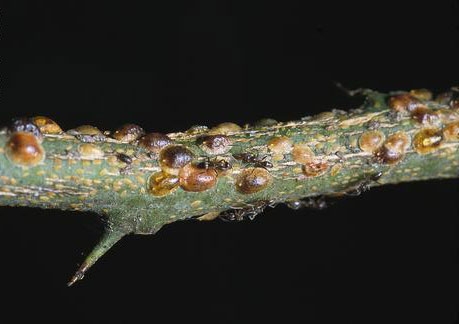
The report, Identifying and Managing Critical Uses of Chlorpyrifos in Alfalfa, Almonds, Citrus and Cotton, was commissioned by the California Department of Pesticide Regulation (CDPR) earlier this year and submitted by UC IPM in October 2014.
“We feel the department entrusted UC IPM with this task because of its reputation for developing effective IPM systems and its track record in bringing groups together to address challenging issues,” said Pete Goodell, UC Cooperative Extension advisor for integrated pest management and report principal investigator. Lori Berger, also of the statewide IPM program, was the project coordinator.
To gather input for the report, Goodell and Berger formed four “crop teams” with leaders from the alfalfa, almond, citrus and cotton industries. While chlorpyrifos is used in many of California's more than 300 crops, these four crops were selected due to the amount of acreage treated and insecticide use patterns. Combined, these commodities are grown on about 2.5 million acres and valued at more than $10 billion per year in California.
Chlorpyrifos is a common insecticide used under the trade names Lorsban, Lock-on and generic formulations to control ants, stink bugs, aphids, whiteflies and other pests. The report details the insecticide's use patterns as compared to other pest control tactics, such as resistant varieties, mating disruption, field sanitation and other insecticides.
“Our industry teams told us that chlorpyrifos is an essential component of their IPM programs,” Goodell said. “The teams believe decision support tools would be useful to help pest control advisers and growers recognize the critical use scenarios that require its application.”
As a part of the discussions, the teams asked that CDPR develop comprehensive, science-based information about the specific risk pathways posed by chlorpyrifos and work with the industry to develop any new application safety measures. The representatives of the agricultural community also asked that new human health data from the U.S. Environmental Protection Agency be considered in future CDPR regulatory decision-making to ensure that the most current data available informs their decisions.
For the second phase of the project, UC IPM will hold outreach meetings in 2015 and 2016 for pest control advisers, UCCE farm advisors, commodity group representatives and farmers who grow alfalfa, almonds, citrus and cotton.
“There is a new generation of professionals coming into the field,” Goodell said. “UC's IPM Program is well-prepared to equip them with decision-making tools that include a wide variety of insect management options.”
The full report can be found on the CDPR website: http://cdpr.ca.gov/docs/pestmgt/crit_uses.htm
An initiative to manage endemic and invasive pests and diseases is part of the UC Division of Agriculture and Natural Resources Strategic Vision 2025.